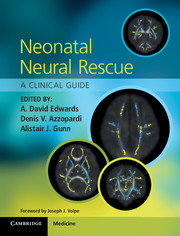Book contents
- Frontmatter
- Contents
- List of contributors
- Foreword
- Section 1 Scientific background
- 1 Neurological outcome after perinatal asphyxia at term
- 2 Molecular mechanisms of neonatal brain injury and neural rescue
- 3 The discovery of hypothermic neural rescue therapy for perinatal hypoxic–ischaemic encephalopathy
- 4 Clinical trials of hypothermic neural rescue
- 5 Economic evaluation of hypothermic neural rescue
- Section 2 Clinical neural rescue
- Section 3 The future
- Index
- References
3 - The discovery of hypothermic neural rescue therapy for perinatal hypoxic–ischaemic encephalopathy
from Section 1 - Scientific background
Published online by Cambridge University Press: 05 March 2013
- Frontmatter
- Contents
- List of contributors
- Foreword
- Section 1 Scientific background
- 1 Neurological outcome after perinatal asphyxia at term
- 2 Molecular mechanisms of neonatal brain injury and neural rescue
- 3 The discovery of hypothermic neural rescue therapy for perinatal hypoxic–ischaemic encephalopathy
- 4 Clinical trials of hypothermic neural rescue
- 5 Economic evaluation of hypothermic neural rescue
- Section 2 Clinical neural rescue
- Section 3 The future
- Index
- References
Summary
The pragmatic tradition
Cooling treatments are part of a noble pragmatic tradition which will try almost anything that might have medical value. There are records going back hundreds of years of physicians submerging newborn babies in cold water to animate them after delivery. Early hypothermic therapy for infants focused on resuscitation and re-animation, rather than neuroprotection. Indeed, no link was made between abnormal birth and later neurological problems until William Little’s classic paper in 1861 [1] and even then it was controversial; Sigmund Freud, for example, famously disagreed.
The 20th century pioneers of infant hypothermia like Björn Westin and James Miller also reported their work more in terms of re-animation than neuroprotection [2], using the concepts and methods of physiology, the dominant contemporary medical science of the time [3–6] and although some children were conscientiously followed up, long-term neural function was not the central issue. The concepts and techniques needed for precise thinking about neuroprotection had yet to be developed.
Lost interest
After this flowering of physiological research interest in therapeutic cooling waned. The problem of resuscitation was solved by mechanical ventilation and Silverman’s influential controlled trial showing that preterm infants survived better if kept warm [7], together with observational [8] and experimental [9] data exposed the potential risks of cooling infants.
- Type
- Chapter
- Information
- Neonatal Neural RescueA Clinical Guide, pp. 33 - 39Publisher: Cambridge University PressPrint publication year: 2013



